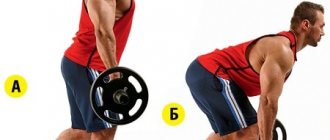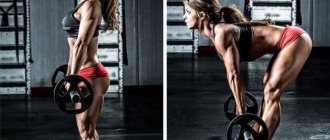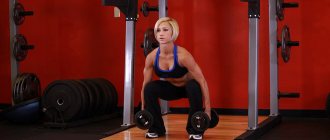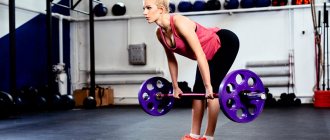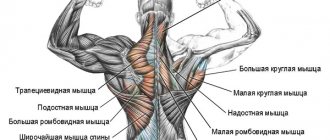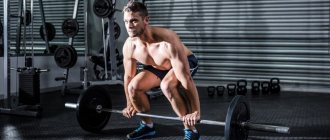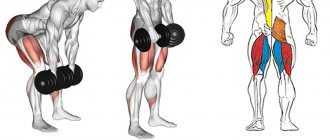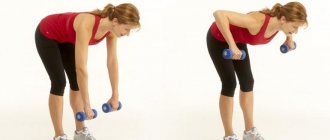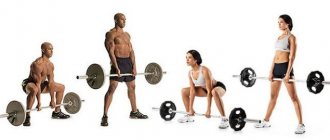The Romanian deadlift is often performed with dumbbells in situations where a barbell is not available or the trainer is trying to strengthen the back and hip muscles using other forms of loading. Please note that the Romanian dumbbell deadlift uses much lighter weights compared to the barbell version. Therefore, it is more suitable for girls or for developing endurance and muscle hypertrophy in men. Also effective in recovering from injury and training at home.
Execution technique
Take a pair of dumbbells (one in each hand) and place them at the sides of your body in front of you. Hold with an overhand grip (palms facing your feet). It is important that the torso is vertical, the arms are straight, and the shoulder blades are brought together and lowered down. This increases tension in the back and prevents unwanted rounding of the shoulders forward.
Place your feet shoulder-width apart and bend your knees slightly to ensure a smooth descent of the weight. Make sure the dumbbells move (slide) vertically near the front of your thighs (don't let them move forward). To do this, move your pelvis back, but keep your back straight and your knees in line with your ankles. As a result, you will feel tension in the back of your thighs (biceps) and throughout your back (bottom and middle, and especially around the shoulder blades). Lower yourself down just below your knees until you feel a distinct stretch in your hamstrings. Pause at the bottom point for 1-2 seconds.
After this, use your buttocks and thighs to push yourself upward. At the top of the movement, tighten your upper back, torso, and glutes.
Inhale as you go down, and exhale as you go up.
Complete the required number of repetitions.{banner_st-d-2}
Romanian deadlift: execution technique
There are several features that make the Romanian deadlift a separate exercise. Since the level of muscle stretching plays a big role with the correct technique, you need to properly stretch the target groups before starting. Otherwise, there is a high probability of injury or stretching of muscles and ligaments. Directly to technology:
- Place the required weight on the barbell and grab it with an overhand grip. Reverse and different grips are unacceptable in this exercise, as they increase the load on the lumbar muscles.
- Place your feet slightly less than shoulder-width apart.
- Bring your shoulder blades together and direct your gaze forward. The gaze position should not change during execution.
- Straighten your legs at the knees - only slight bending is allowed.
- The grip of the barbell should be approximately shoulder-width apart.
- Lower your body with the barbell in your hands by moving your pelvis back and tilting your upper body. In no case should you bend your back - it should always be straight.
- Move your pelvis back not by bending your knees, but by moving your entire legs back.
- At first, it will be quite difficult for you to lower the barbell below knee level. The reason is stretching - over time you will notice that it becomes easier to do deep dives.
- The weight should be lifted to the starting position by working the back and buttocks.
In general, although the exercise is similar to a classic deadlift, it has a number of nuances that I would like to draw your attention to.
Recommendations for performing deadlifts
As the target muscle groups change, weight is transferred from the strong leg extensors to the flexors, and this will affect the working weight. With the Romanian deadlift you will never be able to lift the same amount of weight as you lift during the deadlift. Therefore, calculate your strength correctly.
It is recommended to start with light weights in order to primarily work on the flexibility and elasticity of ligaments and muscles. If you can get the bar down to your feet from the start, you have impressive flexibility.
Common mistakes
There are a number of typical mistakes that are common not only to beginners, but also to experienced athletes. All of them affect the effectiveness of the exercise, and can even lead to injury.
- Your gaze should always be directed forward - do not change the position of your head either while lowering the barbell or while lifting it.
- An indicator that you need to reduce the weight on the bar is a rounded back. This is a signal that the lower back does not have enough strength to perform, so the entire back began to work.
- Some athletes manage to combine Romanian deadlifts with shrugs. When you reach the top position, your shoulders should neither rise nor fall - fix their position and maintain it throughout the exercise.
- Your legs should be at the same level - draw an imaginary line on which your feet will be placed. Otherwise, you will not only lose stability, but will also cause spinal curvature.
- Regarding the grip, it should be straight. A reverse grip does not allow you to perform the exercise technically correctly, and a different grip creates a torque that has a detrimental effect on the health of the lower back.
To prevent back injury, you can additionally use a weightlifting belt. Since the exercise specifically targets the back of the legs, using a belt will not make too much difference to the exercise.
Romanian deadlift with kettlebells
Kettlebells are an excellent piece of equipment for home workouts, various fitness rooms and sports centers. Used to increase strength and train movements.
Unlike the Romanian barbell deadlift, using a kettlebell (or dumbbells) helps eliminate asymmetrical (one-sided) muscle development and better strengthen your back, since each side can be worked independently of each other. More often used as an auxiliary exercise for training programs for gaining muscle mass.
Barbell deadlift: features and technique
The classic version of the deadlift is aimed at working the lower back, trapezius muscles, hip stabilizers and buttocks.
The exercise is performed as follows:
- We stand close in front of the bar: feet approximately shoulder-width apart, shins in contact with the bar;
- We lean forward, keeping our back straight, and grab the bar with our hands. Your arms should be parallel to each other, at right angles to the bar: this will protect your hands from injury when lifting heavy weights. You can take the barbell with a different grip: one hand clings under the barbell, and the other on top of it. With this grip, it will be possible to perform a greater number of repetitions with greater weight: this technique can be used if the forearms and hands become very tired during the approach;
- We straighten up with the barbell in our hands, simultaneously straining our legs and back. The bar should slide closely over the body (at first, the athlete can seriously injure the front of the shins with the bar sliding over it: to avoid this, you can wear special leggings or tight pants);
- We perform 1-2 warm-up approaches with an empty bar. After this, use pancakes as additional weights.
Execution technique
If you still cannot master the correct technique for performing a classic deadlift, you can try a “partial deadlift.” Pulling from plinths (stands for a barbell) or two low benches will help relieve excess tension from the back that occurs during straightening.
An incomplete deadlift will promote the growth of lagging muscle groups: for tall athletes, this is sometimes the only way to finally feel the muscles of the back, and not the legs.
By adjusting the height of the plinths you can shift the load:
- If you pull the weight from a position “below the knees”, the erector spinae and quadriceps muscles will be involved in the work;
- If you pull the weight from a position “above the knees,” only your back will be involved in the work.
Sumo deadlift
The Sumo Deadlift is a classic powerlifting exercise designed to maximize the amount of weight lifted. The exercise is performed with a wide stance - approximately 2 shoulder widths.
Technique:
- We stand in front of the barbell, feet 2 shoulder-widths apart, toes spread to the sides. Keeping your back straight, bend your knees and grasp the barbell with both hands. Recommendations regarding grip are the same as for classic deadlifts;
- In one coordinated movement, we lift the weight, pushing the pelvis forward and quickly straightening up. While moving, we focus on the heels: they should be pressed into the floor (for this you need suitable shoes with flat, non-slip soles);
- At the top point we take a short pause and, moving the pelvis back, return to the first position.
Trap bar row
Equipment such as a “trap bar” or trap bar is quite rare in gyms; it looks like a large frame with weights hung on both sides. When performing deadlifts with a trap bar, the buttocks, hamstrings, and back (especially the extensor muscles) are involved.
Technique:
- We stand in the center of the projectile, lower our hips until they are parallel to the floor. We take hold of the handles;
- Holding the projectile in your hands, we gradually straighten our legs, returning to the starting position. The center of gravity must be shifted to the heels.
The advantage of this exercise is its ease of execution: it is often recommended for beginners. There is no need to look for a comfortable position for the barbell, in which it does not “scratch” your shins until they bleed. In addition, the arms are in a natural position, which allows you to perform more repetitions or increase working weights without the risk of injury.
The ideal geometry of movement in this exercise allows you to “hammer” the back muscles to failure: extensors, latissimus, major and round muscles.
Romanian single leg deadlift
The single leg variation is a unilateral exercise that improves balance, coordination, and the development of muscle groups and strength on each side individually. When performing a standard Romanian deadlift on two legs, it is possible to overlook the asymmetry of movement and disproportionate muscle development. Using each leg individually can correct muscle imbalances and prevent the possibility of injury.
The hamstring (hamstring) is one of the most commonly injured muscles in various sports.{banner_st-d-1}
Differences between the Romanian deadlift and the deadlift
The choice between deadlift and deadlift is determined by many criteria. Despite the external similarity, these are two completely different exercises, as they involve different muscle groups.
Differences between deadlift and deadlift:
- When deadlifting, each repetition should be accompanied by lowering the barbell to the floor. Whereas when performing the Romanian, the barbell is constantly suspended, without falling to the floor even at the lowest point.
- Since the Romanian deadlift is performed with almost straight legs, the calf muscles and quadriceps femoris are almost completely excluded from the exercise. Instead, when you move your pelvis back and lift the barbell, your thigh muscles and the back of your buttocks are activated.
- When performing a deadlift, the extension of the body at the top point should be brought to the maximum, that is, the spine becomes straight. But in Romanian, doing this is not only unnecessary, but also impractical.
- The Romanian deadlift focuses on working the legs, while the deadlift is designed to strengthen the back.
Among girls, the Romanian deadlift is one of the most popular exercises. Thanks to the effective pumping and stretching of the gluteal muscles, the practice of this exercise allows you to achieve aesthetic buttocks.
Alternative variations of the Romanian deadlift
In situations where an athlete or coach wants to replace the Romanian deadlift with something due to lower back or spinal pain, fatigue or a desire to diversify the training program, the following exercises can be used: Good morning. This is a good alternative exercise to enhance the development of the lower back and glutes while limiting the stress on the hamstrings, which are less involved. Most often performed with a barbell or expander.
Reverse hyperextensions are a very good exercise for working the buttocks and muscles that straighten the spine (its lower part), without loading the back of the thigh. The fact is that the movement occurs in the hip joint, and not in the knee or ankle. You can do it with weights, on a reverse hyperextension machine, or simply with your own body weight.
Glute ham raises are used to work the hamstrings in isolation with minimal stress on the spine. Suitable for people who want to protect their back due to injuries or too intense stress. Mostly performed with your own weight or a small weight pressed to the chest. Done with a lot of repetitions.
Scandinavian hamstring curls. Very similar to the previous exercise. The same muscles are loaded. Performed with the help of a partner, and, as a rule, done only with your own weight.
Preparing to perform deadlifts: auxiliary exercises
The deadlift is a difficult exercise: without the correct technique and sufficient physical preparation, it can lead to spinal injuries. Beginners who have just started training first need to master several auxiliary exercises:
- Bent-overs with a barbell while sitting . Take the barbell, place it comfortably on your shoulders and sit on a gymnastic bench (lengthwise, the bench should be between your legs). We perform from 8 to 12 bends, with a straight back. At the lowest point we lower the stomach between the thighs. This exercise will help stretch the back extensor muscles, preparing the athlete for further stress;
- Hyperextension . Extending your back on an incline Roman bench will help prepare your lower back for the stress of a deadlift.
Most often, beginners perform deadlifts by leaning forward heavily and overloading the lower back. This is due not only to incorrect technique, but also to insufficient mobility of the hip joint. To develop it, and at the same time improve your deadlift technique, exercises with kettlebells are perfect:
- We place our feet on both sides of the weight (optimally 16 kg) one and a half shoulder width apart, bend our back, bend our knees slightly and pull the weight with both straightened arms;
- Starting position “feet shoulder-width apart”, place 2 weights on each side of you, bend your back and, slightly bending your knees, lift the weights: this exercise clearly explains the principle of deadlift.
